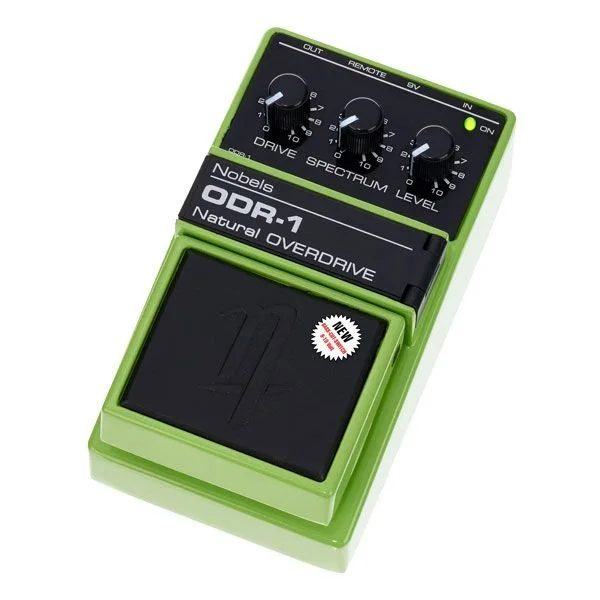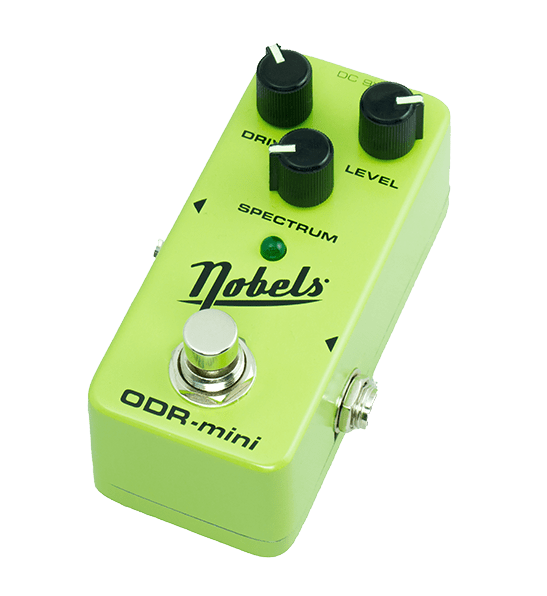The Nashville Secret Overdrive
For years, I had heard about this “secret of Nashville pros” overdrive and then in short order, the secret was being talked about everywhere. The secret, if you don’t know is from Nobels and is called the ODR-1, sometimes known as the “other green overdrive”, which I presume means that the Ibanez Tube Screamer in one of its many iterations is “the” green overdrive. I’ve had a Tube Screamer TS-9 for decades. I know that some folks love them. Mine is in a box.
Be clear that the ODR-1 is not a tube screamer at all. The design and goals are very different and in my personal opinion, that is a huge win.
I first got a sense of the ODR-1 on Youtube channels and then when I got my Browne Amplification Protein Overdrive, it was said that the green side was like an ODR-1. I like the Protein a lot. In one pedal, it delivers most anything I need from an overdrive perspective in my wet / dry / wet rig.
I was recently checking Amazon Canada, as I am wont to do and found for the first time the availability of a Nobels ODR-1 that did not have to ship from the US and was not priced into the stratosphere, so I ordered it. It arrived the next day. The unit looks new, but the box looks like it has been beaten hard. I was cautious and plugged it in using a battery for power and found that it works.
The ODR-1 comes with a very basic instruction sheet, that shows where the battery goes, where the bass cut switch is and has some graphics of places to start for popular sounds. Like some pedals the control naming is odd. Instead of tone, they have Spectrum, which is midrange/treble control. It goes from quite muddy to ear bleeding bright and the position you choose will vary based on your choices on Drive and Volume.
It’s my opinion, for the kind of use cases that I have, that the drive is better left low. Turned up the high end does tend to disappear and the sound gets almost to the point of fuzz. The volume control is purely there to offset the settings of the Spectrum and Gain controls. The foot switch is of the Boss look and is very quiet.
The pedal has in, out, power and remote, which allows you to rack the ODR-1 and turn it on and off via a foot switch on the end of a cable. Not a use case for me, but I can see how some would like it.
With single coils, especially a Telecaster, it’s really spectacular in its default mode. When using my ‘90 PRS Custom 24, I had to engage the bass cut switch when using the humbuckers because it just got too wooly for me. In the coil tap position it’s not bad with the bass cut engaged, but I think I would leave the cut on for those types of guitars and use the guitar tone pot to get the sound that I want.
I first tried it going into the Boss IR-200 that I have on evaluation and discovered that it sounded very “right” with the Boss Twin amp emulation, and a 2x12 cab sim with ribbon microphones. When I switched the IR-200 to one of the British Stack presets which already sounds overdrive, the gain staging of the ODR-1 in front of the IR-200 did some very nice smoothing without a massive tone change. I better understand the thought process behind gain staging the more that I do it, and it is my perspective that the ODR-1 is a perfect pedal to be part of a value chain that does this.
The unit runs on the aforementioned 9V battery and the DC power port is rated from 9V to 12V. I moved it to an existing board and have set the CIOKS to send it 12V instead of 9V which in theory should expand its headroom.
I am impressed with the ODR-1. It’s not a tube screamer, which do not enthuse me, it is different from a Klon clone or Revival Drive and definitely has its own sweet spot. If you can find one online in your own country, the price is quite low for a unit with this level of professional adoption, I paid about $175 CAD for mine. The one I got is the newer version with the bass cut switch option, and for me that’s the right choice, although I would prefer it if the switch wasn’t buried deep in the battery compartment,
Newer versions will now use between 9v and 18v and there is also a Nobels ODR-1 Mini pedal with the same controls but without the bass cut switch for $110 CAD. For those who would prefer to have the ODR-1 in their DAW, there is also a plugin version, available via that link to the Nobels website and it looked to be about $27 USD.
The newest units have glow in the dark indicators on the knobs. I have to go check mine because I tend to play where there are lights. Given that I like building boards and then not futzing with them, I purchased a Mini to use on the board that drives my REVV D20 which I only use for recording. I’ve discovered that with a choice of gain stages on that board, I get pretty much anything that I want. The other pedals are an Analogman Boost and a JHS Morning Glory so I have a very nice gain stage chain there. I do find that the Mini is subtly different in terms of sound to the older larger unit. My Mini has a notch position for the Spectrum knob and no bass cut switch as noted before. In the current implementation, I don’t find that I need the bass cut at all. I’m currently running it at 9V until I get another CIOKS DC 7 for that board to replace the offshore power supply that runs it right now.
I particularly like the ODR-1 for when I want a little bit of grit and not a lot of it. With the Drive down lower it opens things up a bit, sort of like a really good boost, adds a little bit of bite and the high end doesn’t get clobbered. I do tend so far to keep the Spectrum at 2 o’clock or higher, but as I try it with different cabinets, that may change. Most of the process so far with the full sized unit has been with cab sims in the Boss IR-200 and I have not spent enough time tweaking my own settings as I tend to find the Boss presets a bit on the overcooked side. I have moved the full sized ODR-1 to one of my wet / dry amp switching systems and have found that it is better with a set of real amps than with the simulations in the IR-200 and headphones.
Nobels units are not ubiquitous here in Canada, but I know of session and studio players who keep one permanently on their session boards. If space is a consideration and you want maximum headroom, the ODR-Mini is your best choice, with the understanding that you need to supply it from an external power supply.
Nobels is very clear in their documentation that when using an external supply if you don’t use an isolating power supply, you are going to get noise. This is not a defect in the unit, it’s the reality in any kind of drive pedal. As far as I am concerned, every vendor should say that clearly. I know that OneSpot daisy chains are effective and inexpensive but their lack of isolated outputs tends to make the entire affair noisy, especially if the source power is not as clean as you would want it to be.
Please post any questions here. Thanks for reading and until next time, peace.



